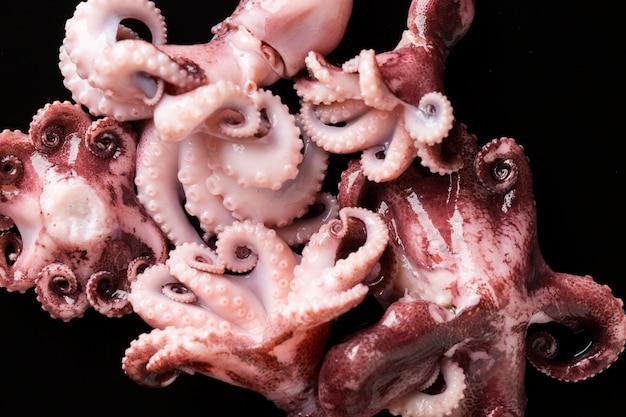Octopus. Just the word conjures up images of tentacles, swirling around in the depths of the ocean. It might seem intimidating, this eight-legged cephalopod, but trust me, it's a real culinary gem. I've been cooking up a storm with octopus for years now, and I'm here to share all my tips and tricks to help you conquer this delightful delicacy. We're going to delve into everything from choosing the right octopus to mastering different cooking methods, and I'll even throw in some of my favourite recipes along the way. So, grab a notepad, put on your apron, and let's get started!
(Part 1) The Octopus: A culinary adventure

Choosing the Right Octopus
First things first, let's talk about the octopus itself. You'll find them in different sizes, from tiny baby octopuses to hefty giants, but for cooking, you'll want to look for a medium-sized one, usually around 1-2 pounds. This size is manageable to cook and offers a great balance of flavour and texture. Imagine it as a satisfyingly chewy but not overly tough bite.
When choosing, look for a firm, shiny octopus with bright eyes and a clean scent. It should smell like the ocean, not fishy or stale. Avoid any that look dry or have a fishy odour.
Preparing Your Octopus: A Little Bit of TLC
Now, before we start cooking, we need to prepare the octopus. It's a simple process, but it's important for removing any impurities and ensuring a tender final product.
The first step is to clean the octopus. This involves removing the beak, which is the hard, pointy part at the centre of the head. You can easily do this with a sharp knife. Then, you'll want to remove the internal organs, which are located inside the mantle, the main body of the octopus. Don't worry, this is a straightforward process.
Once you've cleaned the octopus, it's time to tenderize it. This is a crucial step, as octopus can be quite tough if not properly cooked. There are a few methods to tenderize octopus, but my favourite is to pound it. Simply place the octopus on a cutting board and use a meat mallet to pound it all over. This helps break down the muscle fibres and makes it more tender. You can also use a knife to score the octopus, making small cuts across the surface. Imagine you're giving it a massage, but with a bit more force!
Another popular method is to blanch the octopus. This involves immersing it in boiling water for a short period of time, usually about 30 seconds. This helps to shock the octopus and make it more tender. It's like a quick hot bath for your octopus.
Marination: A Symphony of Flavours
Once your octopus is cleaned and tenderized, you can move on to marination. This step is not essential, but it's a great way to add a burst of flavour and infuse the octopus with a delicious aroma.
I like to use a simple marinade made with olive oil, lemon juice, garlic, salt, and pepper. You can get creative here and experiment with different herbs and spices. For a Mediterranean twist, add oregano and rosemary. For a spicy kick, try adding chili flakes. Let your imagination run wild!
Let the octopus marinate in the fridge for at least 2 hours, or even overnight, for maximum flavour penetration. The longer you let it marinate, the more the flavours will meld and create a symphony of taste.
(Part 2) Octopus Cooking Methods: A culinary journey

Now that our octopus is prepped and ready to go, it's time to dive into the different cooking methods. From classic techniques to innovative approaches, there's a world of possibilities when it comes to preparing this versatile cephalopod.
Boiling: A Simple and Reliable Method
Boiling is the most classic way to cook octopus, and it's surprisingly straightforward. Bring a large pot of salted water to a boil, then gently lower the octopus into the water. Make sure the water is still simmering, not boiling furiously, as this can toughen the octopus. Think of it as a gentle simmering bath for your octopus.
Cook the octopus for about 30 minutes, or until it's tender. You can test for doneness by poking it with a fork – it should feel tender and give easily.
Grilling: A Smoky and Delicious Option
Grilling octopus is a fantastic option for those who enjoy a smoky flavour. Simply grill the octopus over medium heat for about 10 minutes per side, or until it's charred and cooked through. You can marinate the octopus beforehand for added flavour, or brush it with a simple glaze made with olive oil, lemon juice, and herbs. The grill adds a delicious smoky char to the octopus.
Baking: A Tender and Aromatic Delight
For a more tender and flavourful result, try baking your octopus. Preheat your oven to 350°F (175°C). Place the octopus in a baking dish and drizzle it with olive oil, lemon juice, garlic, and your favourite herbs. Cover the dish with foil and bake for about 45 minutes, or until the octopus is cooked through. The oven will slowly cook the octopus, creating a tender and juicy result.
slow cooking: Tenderness at its Finest
If you're looking for the ultimate tender octopus, slow cooking is the way to go. Place the octopus in a slow cooker with olive oil, lemon juice, garlic, and your favourite herbs. Cook on low heat for 6-8 hours, or until the octopus is incredibly tender. The slow cooker gently breaks down the tough muscle fibres, resulting in the most tender octopus imaginable.
(Part 3) Octopus Recipes: A Culinary Adventure

Now, for the fun part, let's get into some delicious octopus recipes that I've been experimenting with for years! I'll share some of my favourites, ranging from classic Greek dishes to modern twists on the traditional.
Classic Greek Octopus Salad: A Refreshing Mediterranean Delight
Ingredients:
1 pound octopus, cooked and sliced
1/2 cup chopped red onion
1/4 cup chopped fresh parsley
1/4 cup chopped fresh oregano
1/4 cup Kalamata olives, pitted and sliced
1/4 cup olive oil
2 tablespoons lemon juice
Salt and pepper to taste
Instructions:
1. Combine the octopus, red onion, parsley, oregano, olives, olive oil, lemon juice, salt, and pepper in a large bowl.
2. Toss to coat and chill for at least 30 minutes before serving. This allows the flavours to meld and create a refreshing and satisfying salad.
Octopus Stew with Tomatoes and Potatoes: A Hearty and Warming Dish
Ingredients:
1 pound octopus, cooked and sliced
1 onion, chopped
2 cloves garlic, minced
1 (28-ounce) can diced tomatoes
2 large potatoes, peeled and cubed
1 cup chicken broth
1/2 cup chopped fresh parsley
Salt and pepper to taste
Instructions:
1. Heat olive oil in a large pot over medium heat. Add the onion and cook until softened, about 5 minutes. Add the garlic and cook for 1 minute more.
2. Stir in the diced tomatoes, potatoes, chicken broth, parsley, salt, and pepper. Bring to a boil, then reduce heat and simmer for 30 minutes, or until the potatoes are tender.
3. Stir in the octopus and cook for 5 minutes more. Serve hot with crusty bread. This stew is perfect for a cold winter's day and will warm you from the inside out.
Octopus Paella: A Spanish Masterpiece
Ingredients:
1 pound octopus, cooked and sliced
1 tablespoon olive oil
1/2 cup chopped onion
2 cloves garlic, minced
1/2 cup chopped green bell pepper
1/2 cup chopped red bell pepper
1 cup white rice
2 cups chicken broth
1/2 cup frozen peas
1/4 cup chopped fresh parsley
Saffron threads (optional)
Salt and pepper to taste
Instructions:
1. Heat olive oil in a large paella pan or oven-safe skillet over medium heat. Add the onion, garlic, green bell pepper, and red bell pepper and cook until softened, about 5 minutes.
2. Stir in the rice and cook for 1 minute, stirring constantly. Pour in the chicken broth and bring to a boil.
3. Reduce heat to low, cover, and simmer for 15 minutes, or until the rice is cooked through and most of the liquid is absorbed.
4. Stir in the octopus, peas, parsley, saffron threads (if using), salt, and pepper. Cover and cook for 5 minutes more.
5. Serve immediately. Paella is a Spanish classic that showcases the versatility of octopus and brings a taste of Spain to your table.
Octopus "Ceviche": A Latin American Delight
Ingredients:
1 pound octopus, cooked and sliced
1/2 cup chopped red onion
1/4 cup chopped fresh cilantro
1/4 cup lime juice
1/4 cup orange juice
1 jalape??o pepper, seeded and finely chopped
Salt and pepper to taste
Instructions:
1. Combine the octopus, red onion, cilantro, lime juice, orange juice, jalape??o pepper, salt, and pepper in a large bowl.
2. Toss to coat and refrigerate for at least 2 hours, or until the octopus is marinated and the flavours have blended.
3. Serve chilled with tortilla chips or crackers. Ceviche is a refreshing and vibrant dish that will awaken your taste buds.
(Part 4) The Art of Octopus Texture: From Tender to Chewy
One of the things that makes octopus so intriguing is its unique texture. It can range from tender and melt-in-your-mouth to firm and chewy, depending on the cooking method and the size of the octopus.
Tender and Melt-in-Your-Mouth
For a tender and melt-in-your-mouth octopus, opt for slow cooking methods like braising or stewing. These techniques allow the octopus to cook slowly and evenly, breaking down the tough muscle fibres and resulting in a soft, delicate texture. It's like the octopus has been given a long, slow massage, resulting in a tender and delicious bite.
Firm and Chewy
If you prefer a firm and chewy texture, grilling or searing is a great option. These methods quickly cook the octopus's exterior, creating a crisp crust while keeping the inside slightly firm. The contrasting textures of the crispy exterior and the chewy interior make for a satisfying dining experience.
Factors Affecting Texture
The texture of octopus is also affected by its size. Smaller octopuses tend to be more tender, while larger ones can be quite chewy.
(Part 5) Octopus with Different Flavours: A Global Culinary Journey
One of the things that makes octopus so versatile is its ability to absorb a wide range of flavours. From spicy Southeast Asian curries to tangy Mediterranean salads, octopus can be incorporated into countless cuisines around the world.
Mediterranean Flair: Olive Oil, Lemon, and Herbs
The Mediterranean diet is a natural match for octopus. Olive oil, lemon juice, garlic, oregano, and parsley combine to create a fresh and bright flavour profile that complements the octopus's delicate texture. This combination creates a taste of sunshine and the sea, evoking images of Greek islands and coastal Italian villages.
Asian Inspiration: Spicy, Savoury, and Aromatic
Octopus is a common ingredient in Asian cuisine, where it's often stir-fried, braised, or grilled. The use of ginger, garlic, chili peppers, and soy sauce adds a bold and aromatic depth to the dish. The spicy, savoury flavours of Asian cuisine bring out the octopus's natural umami richness.
Latin American Passion: Zesty, Citrusy, and Vibrant
In Latin American cuisine, octopus is often featured in ceviche, a refreshing dish of raw fish or seafood cured in lime or lemon juice. The addition of chili peppers, onions, and cilantro adds a vibrant and zesty flavour. Ceviche is a celebration of fresh flavours and textures, with the octopus adding a unique chewiness to the dish.
(Part 6) Octopus: A Sustainable Choice
Beyond its deliciousness, octopus is also a sustainable choice. Compared to other seafood options, octopus has a relatively low environmental impact. However, it's still important to be mindful of where your octopus comes from and ensure it's sourced sustainably. Look for certified sustainable seafood labels and support responsible fishing practices. This way, you can enjoy delicious octopus while also contributing to the health of our oceans.
(Part 7) Mastering the Octopus: Tips and Tricks
Over the years, I've learned a few tricks of the trade when it comes to cooking octopus. Here are a few tips to help you achieve perfectly cooked octopus every time:
Don't Overcook: Octopus can quickly become tough if overcooked. It's best to cook it slowly and gently to ensure tenderness. Think of it as a delicate dance, not a rushed sprint.
Test for Doneness: Poke the octopus with a fork to test for doneness. It should feel tender and give easily. This is your cue to stop cooking and let the octopus rest.
Refrigerate for Flavor: Allow the cooked octopus to cool and refrigerate it for at least 30 minutes before using. This helps the flavours meld and enhances its texture. It's like giving the octopus a chance to relax and settle into its new form.
Experiment with Flavours: Octopus is incredibly versatile, so don't be afraid to experiment with different marinades, sauces, and spices. Let your culinary creativity shine!
(Part 8) Frequently Asked Questions (FAQs)
1. How do you know when octopus is cooked?
You'll know your octopus is cooked when it's tender and gives easily when poked with a fork. It should also change colour, turning a darker, slightly reddish hue.
2. How long does octopus take to cook?
The cooking time for octopus depends on its size and the cooking method you choose. Generally, boiling takes about 30 minutes, while slow cooking can take 6-8 hours.
3. Can you eat octopus raw?
While some people might enjoy raw octopus, it's not recommended. Octopus can contain harmful bacteria that can cause food poisoning. It's best to cook it thoroughly to ensure safety.
4. What are the health benefits of octopus?
Octopus is a good source of protein, vitamins, and minerals. It's also low in calories and fat, making it a healthy choice for a balanced diet. It's a nutritious and delicious addition to your meals.
5. What are some other ways to cook octopus?
Beyond the methods we've discussed, you can also sauté octopus, deep-fry it, or even add it to stir-fries or pasta dishes. The possibilities are endless!
Octopus: A Culinary Adventure Awaits!
There you have it, a comprehensive guide to cooking octopus, from choosing the right one to mastering different methods and experimenting with flavours. Remember, the key is to be patient, experiment, and embrace the culinary adventure. I hope you enjoy this delicious and versatile cephalopod as much as I do!
Everyone is watching

Prime Rib Roast Cooking Time Chart: Per Pound Guide
Cooking TipsPrime rib roast. Just the name conjures images of lavish dinners, crackling fires, and hearty laughter. It’s ...

How Long to Bake Potatoes in the Oven (Perfect Every Time)
Cooking TipsBaked potatoes are a staple in my kitchen. They're incredibly versatile, delicious, and surprisingly easy to m...

Perfect Rice Every Time: The Ultimate Guide to Cooking Rice
Cooking TipsAs a self-proclaimed foodie, I've always been a bit obsessed with rice. It's the foundation of countless cuisi...

The Ultimate Guide to Cooking Asparagus: Tips, Techniques, and Recipes
Cooking TipsAsparagus. The mere mention of this spring delicacy conjures up images of vibrant green spears, crisp and burs...

Ultimate Guide to Cooking the Perfect Thanksgiving Turkey
Cooking TipsThanksgiving. Just the word conjures up images of overflowing tables laden with delicious food, the scent of r...
